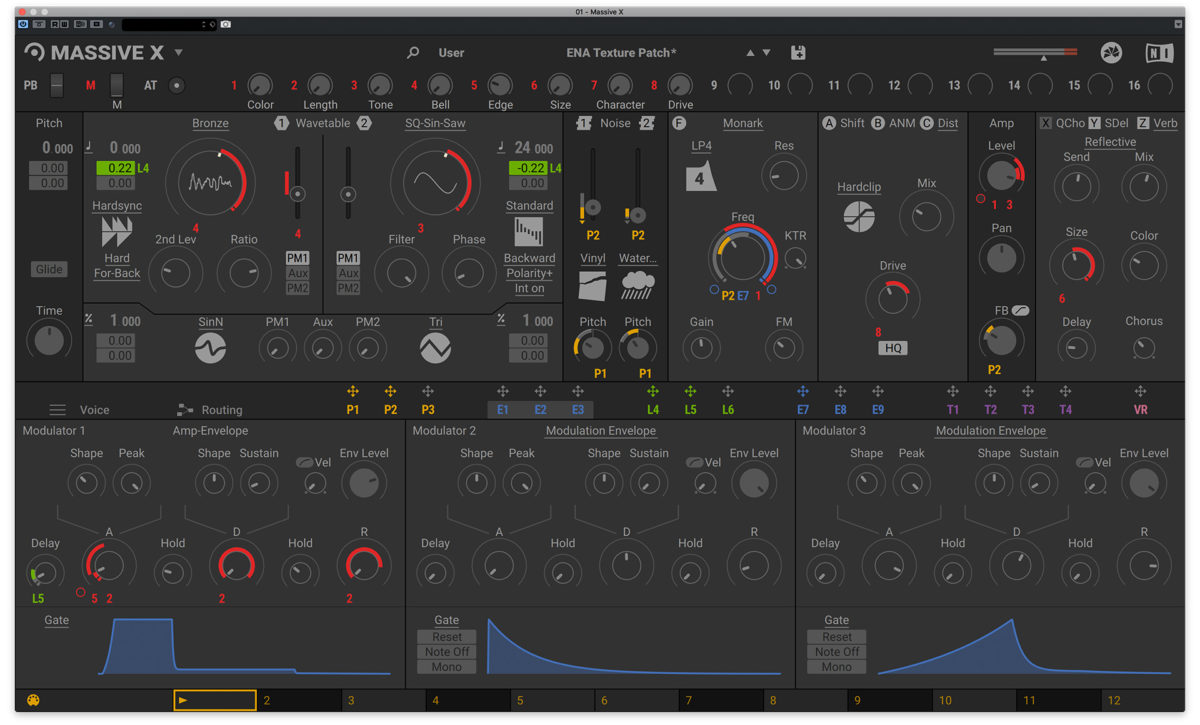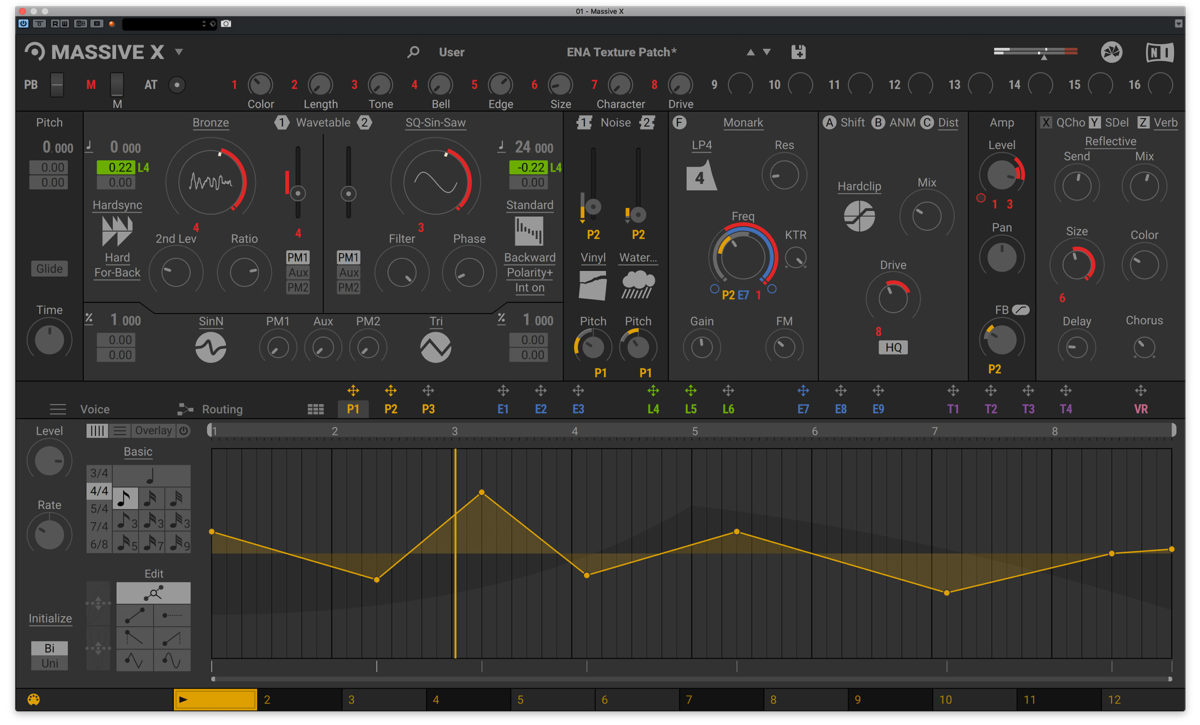A figurehead of the Japanese underground scene, Tokyo-based producer ENA has been forging his own brand of darkly abrasive yet achingly beautiful electronic music since the mid-noughties. From classic drum ’n’ bass and rave to hip-hop and heavy metal, there’s no stylistic form that this forward-thinking artist considers off limits for assimilation, and the deft manipulation of substructure and noise is a key component of his sound. And aside from this experimental streak, he’s also carved out a day-job penning hits for some of Japan’s biggest pop acts and music for commercials.
With all that in mind, we tasked ENA with encapsulating his thoughtful, high-concept approach to sound design and production in a single MASSIVE X patch. The result is a complex, versatile preset, with eight Macros enabling seamless transmutation from short, bright lead to dark, languid pad, or anything in between. Particularly noteworthy are the slow, untriggered modulation of the two Noise generators’ volume and pitch by Performers 1 and 2, creating a constantly shifting atonal layer; and the application of Performer 2 to the filter alongside Envelope 1 and Macro 1, which further adds to the movement of the sound with sustained notes.
Listen to the patch in action above, download it for free here, then read on to find out how this MASSIVE X masterpiece was made and discover the thought processes behind it.

Tell us about yourself and your music.
I grew up in a classical music family, so taking up music and pursuing it as a career was natural for me. From the very beginning, I played musical instruments – I still play them now. But how do I effectively describe what I’m doing now? My intention is to make dance music, but I guess it’s up to the listener to decide how to relate to what I make.
We’d say the music you produce covers a wide spectrum of genres. Are you conscious of your musical inputs?
I listen to anything, from Top 40 chart music to traditional soul, urban and ‘60s music. And I love heavy metal. I really like J. J. Cale and Albert King, although what I make is far removed from it. I don’t think that kind of music can be quantified in numbers. It’s not about frequency ranges or production values – it doesn’t concern itself with any of that stuff – so in a way, it’s a distillation of everything that modern music doesn’t possess.
What were your first experiences with MASSIVE X?
Up until now, my impression of ‘digital’ sound was something unpleasant – ‘edgy’ perhaps – but here, I find a certain roundness, a certain analog feel and texture. It’s not about the sound being ’fat’; it’s more like it has a musical depth to it. There’s a ‘reality’ to MASSIVE X.
When you play the piano, you can still feel the resonance and a certain reverberation – atmosphere, if you will – even after you release the keys. With soft synths until now, the moment you take your fingers off the keyboard, the release expires, the sound stops, and suddenly the atmosphere, the ‘world’ of that synth, ends with it. Analog synths are different – there’s background noise and various artefacts, so even when the sound stops, its ‘world’ persists. That quality is present in MASSIVE X.
The patching is pretty straightforward and self explanatory, too. Considering the sheer amount of functionality this synth offers, I expected to have to delve deep to access everything, but MASSIVE X’s GUI made the process simple and intuitive.

How did you approach making your patch?
I wanted to make a patch that can be played normally on a keyboard, rather than some kind of screamer. I wanted to make something that could be used as an instrument, and I wanted to be able to transform the character of the sound gradually using Macros, to be able to go from a pluck sound to a drone. If one sound could transform in many ways, you could create music without an ensemble of instruments. This patch becomes the starting line, but it is not the definition of itself. If the sound can vary, you have a wider palette of expression.
The basis of my idea was to go beyond the usual 12-tone scale and add expression through use of texture, envelopes and frequency structure. I thought it would be interesting to utilize the texture and character of MASSIVE X to create this sound.
Which MASSIVE X features did you use in the making of this patch?
At first, I used the Performer. It’s a bit more convoluted than an LFO and I can randomize the texture movements, which makes it less likely that you’ll end up with the same sound. It’s easy to use and self-explanatory. I assigned it to the Noise generator’s volume and to pitch. There are two simple Noise generators, which are kind of crossfading. If the pitch of one rises, the pitch of the other falls; and it’s randomized, so even though it’s simple, it sounds rather complex. The Performer modulation is slowly moving in the background, independent of the song tempo, basically doubling the layers. I programmed it that way so that you would never get the same sound twice.

That’s the thing with digital sounds: they can reproduce the same sound again and again. If you take guitar as an example, even when you play the same part twice, it’s unlikely that you’ll actually produce the same sound. So I paid special attention to giving this sound a certain degree of randomness to underpin the sense of texture.
Opening or closing a filter changes the perceived volume of a sound, which can sometimes make it difficult to use that sound consistently in a song. Since I have the filter mapped to a Macro, I’ve also mapped that Macro to go up or down in volume to counter the perceived volume changes when using the filter. So essentially, whether you’re opening or closing the filter, the levels should remain consistent.
I’ve also used an Exciter Envelope, which is working to create deeper contrasts in the attack part of the sound. There’s a certain uniqueness to the character of this envelope, which can’t be achieved with regular envelopes.
How do presets influence your music making process?
I find presets indispensable when working on commercial music. Quite often, there’s hardly any lead time for the project, so it would be pretty hard to meet deadlines if I didn’t have presets. It’s simply quicker to pick a preset and adjust it to my needs. More often than not, the deadlines are extremely tight and it’s always a race against time to complete the project within the allocated time. I think the use of presets is inevitable.
Interview: Ryo Takahashi
Header photography: Jimmy Mould
Check out ENA’s music on his website, or purchase via Bandcamp.
















